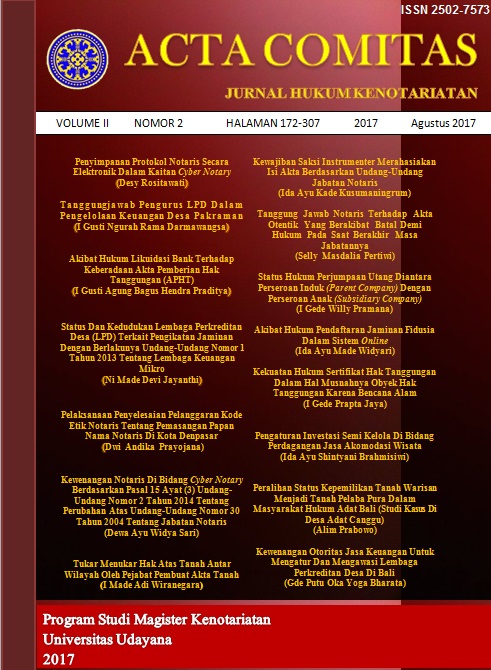KEWENANGAN NOTARIS DI BIDANG CYBER NOTARY BERDASARKAN PASAL 15 AYAT (3) UNDANG-UNDANG NOMOR 2 TAHUN 2014 TENTANG PERUBAHAN ATAS UNDANG-UNDANG NOMOR 30 TAHUN 2004 TENTANG JABATAN NOTARIS
English
Abstract
Based on the descript ions of Art icle 15 point (3) of Law No. 2 of 2014 on the
Amendment of Law No. 30 of 2004 on Posi t ions of Notaries Publ ic i t i s state that the
Notary has the authori ty to cert i fy the elect ro nic t ransact ion (cyber Notary ).
However, unt i l today there st i l l exi st s legal void regarding technical implementat ion
rule regulat ing the authori ty of notaries. Based on thi s background the i ssue herein
rai sed i s how elect ronic t ransact ion made by notaries wi l l be done? and how wi l l
elect ronic t ransact ions be done by the part ies domici led out side the juri sdict ion of
the notaries pract icing regions?
Thi s research was classi f ied into normat ive legal research wi th approached by
conceptual and statute approach . The legal material of thi s research were based on
primary, secondary and tert iary legal material s. The legal material s was be
descripted henceforth to interpreted, constructed, systemat i zat ion, analysed,
evaluated, and al so given argument to get conclusi on of the problems.
Based on study conducted, the solut ion can be found, Fi rst , that based on the
theories of legal certainty, progressive law and state legal concept the creat ion of
elect ronic t ransact ion by notaries may be conducted video conference. Th e creat ion
of elect ronic t ransact ions by notaries publ ic is simi lar to de process of creat ing
convent ional notari zed deeds, whereby af ter the draf t i s prepared, the content wi l l
be read out by the notary publ ic to be signed later by the part ies. The signin g part ies
wi l l be able to see and read the draf t on the computer screen or the elect ronic
medium in use. And af ter the part ies approve the content , the notary publ ic wi l l ask
the f i rst party to sign the deed using the digi tal signature. The notary publ ic t hen
veri f ies the signature and unt i l al l the part ies af f ix thei r elect ronic signature upon
the deed. Second, based on the concept of legal state, theory of authori ty, theory of
norm classi f icat ion and principle of preference, notaries wi l l be able to draw up
elect ronic t ransact ion of the part ies whose domici le in out side pract icing area of the
notaries.
Downloads

This work is licensed under a Creative Commons Attribution 4.0 International License.






